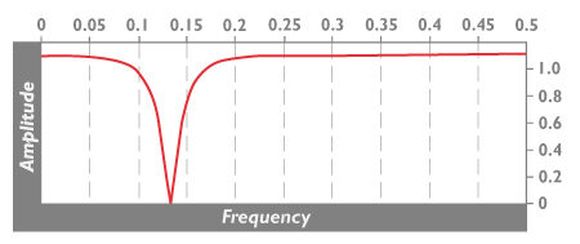3. Feedback Elimination
Notch Filters & Dynamic Feedback Rejection
One of the inherent dangers in amplifying acoustic instruments is that of feedback. While some manufacturers have attempted physical remedies - thinner bodies and sound-hole covers for instance - these all have a detrimental effect on the sound of the instrument, and the main means of tackling the problem today are electronic.
Most feedback occurs at a specific frequency, typically a howl at an identifiable pitch. Most electronic feedback solutions therefore involve some form of EQ to remedy the situation. The standard frequency bands of most equalisers, however, are far too wide to reduce feedback without seriously affecting basic sound quality thats what theyre for, after all.
Seek and Destroy
The device required is a notch filter: a very narrow, high rejection EQ band.
While fixed or manually variable notch filters have their uses, most feedback is unpredictable, occurring at different frequencies depending on the instrument, venue and gain structure. Dedicated feedback elimination works by continually analysing the incoming signal, and then varying the frequency, width and gain reduction of the notch filter in order to eliminate any feedback detected. By this means, the filter frequency can usually be extremely narrow, with little other audible effect on the signal.
Some amps also feature a manually activated notch filter which can be set to reduce the known resonant frequency of your instrument, usually in the region of 120Hz.
Phase Reversal
Another technique for dealing with feedback involves simply inverting the phase of the amplified signal. The reason this works is due to the very nature of feedback: the guitar resonates in response to sound from the speakers - if a certain frequency is highly resonant, it will be heavily present in the amplified signal, which will cause the guitar to resonate even more at that frequency, and so on in a vicious circle. When this happens, it happens very quickly the effect increases with every cycle until limited by the maximum gain of the amplifier. Inverting the phase of the amplified signal means that any vibration of the guitar body at that frequency is discouraged by the amplified signal, because at any given time it is pushing or pulling in the other direction. In the real world, the efficacy of this method depends on many factors including the distance and angle between the guitar and amp, but it remains an interesting technique and is featured on some acoustic amps.
High-Pass Filter
Very low frequency feedback can be suppressed with a simple high-pass filter. This is usually set with a cut-off frequency of around 80Hz to eliminate any low frequency feedback, mains hum and guitar body noise below the guitars musical range (the guitars open low E string has a frequency of 82.4Hz).


